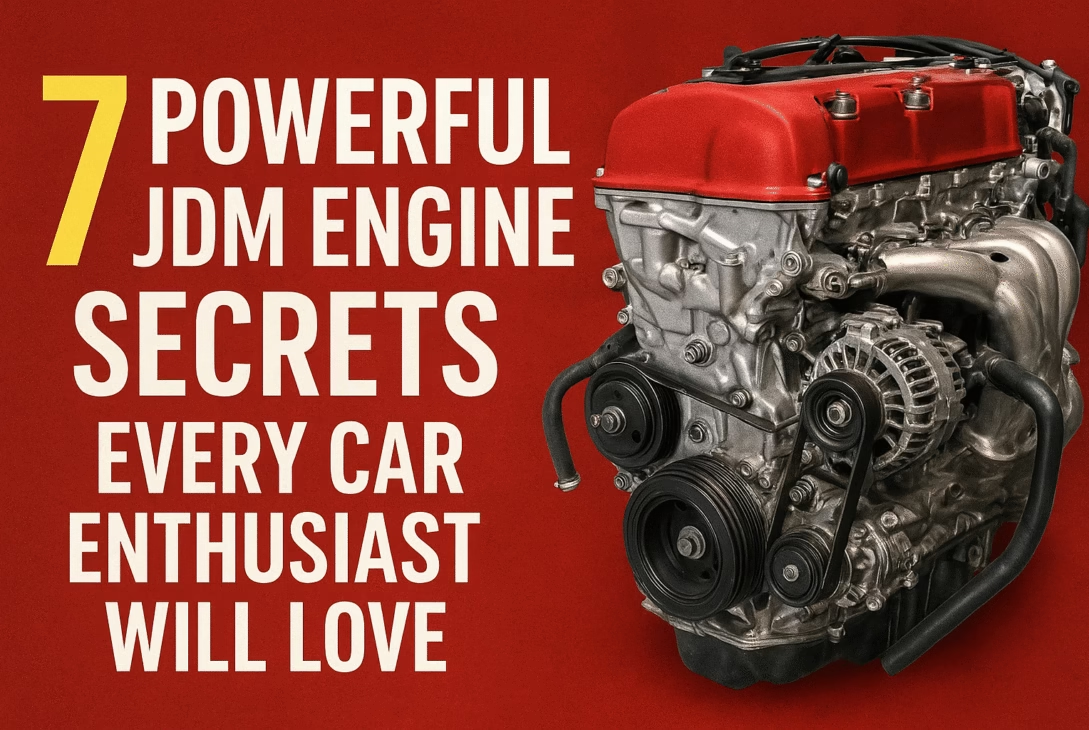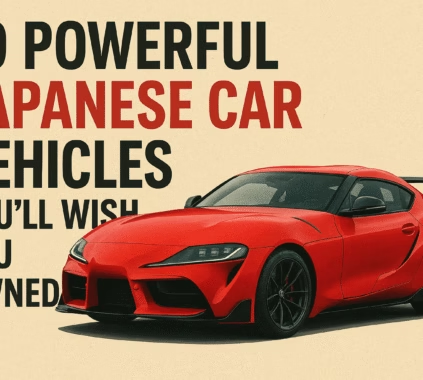Ever since its creation, JDM has always been an uncharted territory of its own, home to legendary machines and performance culture that has amazed enthusiasts for generations.
Table of Contents
The pulse of this world is the JDM Engine. These marvels of engineering are more than just mechanical components they are crafted with a philosophy of ensuring reliability, efficiency, and astonishing power.
Many hear “JDM Engine ” and instantly think of cars with VTECs that scream, grumpy inline-sixes, and the taste of yellow.
But there is more to the engine than meets the surface. In this article, we will delve deep under the valve cover and uncover the secrets and astonishing truths that make the JDM Engine legendary.
From untold “Gentlemen’s Agreements” to secrets of engineering that defy the very laws of logic, there is no doubt that you will leave with a better understanding and appreciation for the JDM engine that pulse through Japan’s performance cars.
The Myth of the 276 Horsepower ‘Gentlemen’s Agreement’

An automotive legend from the history of JDM from the 1980s states that the ‘Gentlemen’s Agreement’ was an unspoken rule by Japanese car companies that limited the claimable horsepower of high-performance automobiles to 276 hp (280 PS).
This informal rule applied to most Japanese cars until the beginning of 2004, primarily for the sake of public safety and to prevent a horsepower competition.
The shocking part, however, is that for most cars created during this period, the claim of 276 hp was the horsepower the marketing team stated to sell the product.
Nissan’s Skyline GT-R (R34) was reportedly equipped with an RB26DETT engine that produced 276 hp, although stock models were closer to 320-330 hp.
Nissan built a race-ready JDM engine, then, for the sake of this agreement, grossly understated the capabilities of the engine.
The iconic 2JZ-GTE engine in the Toyota Supra (JZA80) was another ‘victim’ of this agreement.
Toyota stated that the Japanese market version of the Supra had a small 276 hp, but the models for export to North America and Europe were rated at a whopping 320 hp.
The variation was in the engine the only difference was the number on the spec sheet.
Mitsubishi’s Lancer Evolution: separately checked Mitsubishi Lancer Evolution IV through to IX and gave each model a rating of 276 hp.
This model, however, showcased more power and speed. Independent testing recorded a rise in output. Later models marketed over 300 hp right from the factory.
This hidden “potential” became a phenomenon. Each manufacturer designed every JDM engine to endure extreme weather conditions.
This was done with the belief that a simple ECU tune or boost controller adjustment would unlock all the hidden power the engine had to offer.
The engines were designed to perfection and were over-engineered. Car tuners later used this to design thousand-horsepower pure monster machines.
Why Some JDM Engines Are Nearly Indestructible
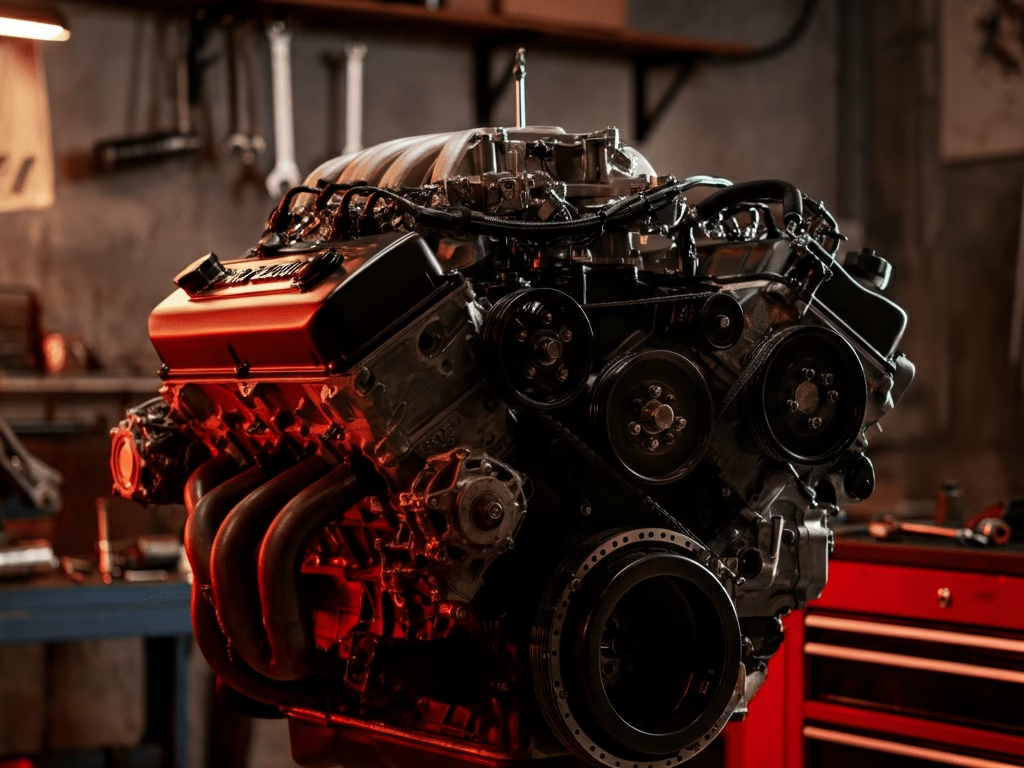
Wondered why the 2JZ-GTE or the RB26DETT engines have the capacity to handle extreme power levels with stock internal components? The answer lies in “over-engineering.’’
Japanese engine manufacturers in the 1990s, during the economic bubble, invested a lot of money in research and development.
Not building an engine to exact specifications, but rather building it to withstand significantly more.
Case Study The Toyota 2JZ-GTE
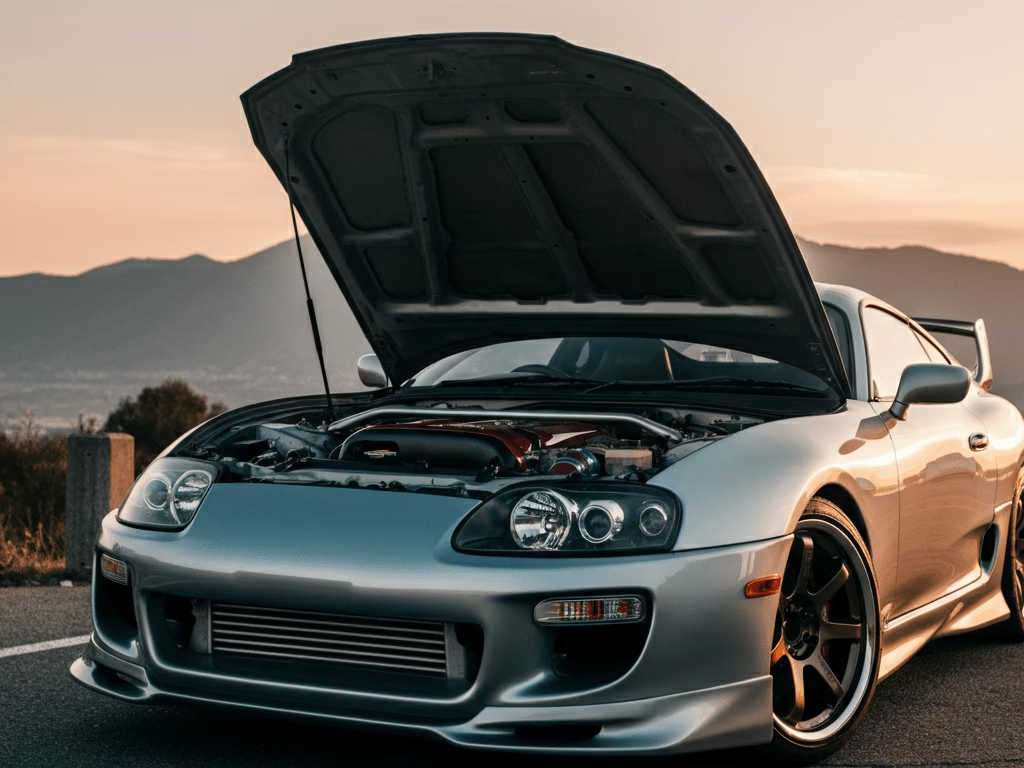
The 2JZ-GTE is found in the Mk4 Toyota Supra and features a 3.0-liter twin-turbo inline engine, which is highly regarded in the tuning world.
Below are the characteristics that make it remarkably durable.
- Closed-Deck Iron Block: The 2JZ features a closed-deck design, which means the block has a solid piece of cast iron surrounding the top of the cylinders, providing immense structural rigidity to the block. This is unlike an open deck block, where the freestanding cylinders are at the top. This closed-deck design ensures that the freestanding walls of the cylinders will not flex or crack under boost and high pressure.
- Forged Crankshaft: The hydraulically activated process of forging a crank is said to be of high industrial strength. This crankshaft, which is said to be forged and relates to the amalgamation of high pressure and withstanding torque, means a forged crank will be able to stand and handle the pressure with ease when the engine’s horsepower is doubled or tripled.
- Robust Piston and Rod Design: The stock rods and pistons, which are replaced for achieving insane power goals exceeding 800 horsepower, can be replaced with any component, and they will work seamlessly. The stock rods and pistons can handle 600-700 horsepower with proper tuning, which is remarkable.
The build quality meant that a standard JDM engine had the foundation of a race engine. To cement the 2JZ’s legacy, this was a purposeful decision.
For more specific insights, consider reading dedicated automotive publications, such as Motor Trend.
VTEC More Than a Meme
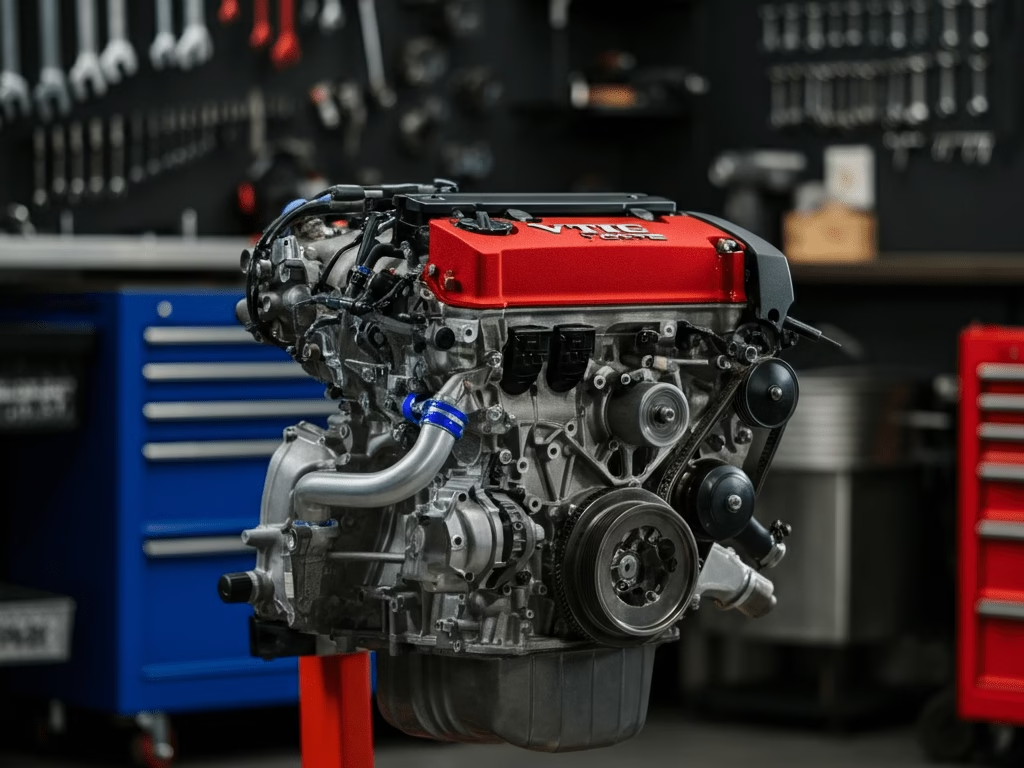
“VTEC just kicked in, yo!” may be a popular line, but the technology behind it is a marvel of engineering. VTEC, invented by Honda, is a system that gives an engine two different personalities.
At low RPMs, an engine is said to run on a mild cam profile. This means the engine idles smoothly, uses fuel efficiently, and has decent low-end torque, which is good for everyday services.
However, the moment an engine speed crosses a certain threshold (which is usually around 5,500 RPM), the car’s computer activates a solenoid.
This solenoid utilizes oil pressure to switch the system, engaging a locking pin that controls a set of rocker arms following a cam profile.
In this specific case, there is a great deal of aggression. The profile is described as high-lift and long-duration, resulting in the following.
The result is an instant and extreme change:
- The Sound Change: The car’s engine note goes from a soft purr to a sharp, high-pitched screech.
- A Surge of Power: The top end of the rev range suddenly unlocks, along with a massive rush of horsepower, when the engine is suddenly breathed with more air.
- High Redlines: On the S2000 and Integra Type R, VTEC lets aspirated engines reach 8,000 to 9,000 RPMs.
A JDM VTEC engine, like a Honda B-series or a K-series, gives you stunning fuel economy and civility on the everyday commute and a screaming race engine on demand.
It is a level of sophistication, even civility, that many modern turbo engines still cannot replicate.
A bold gamble, The rotary revolution Mazda
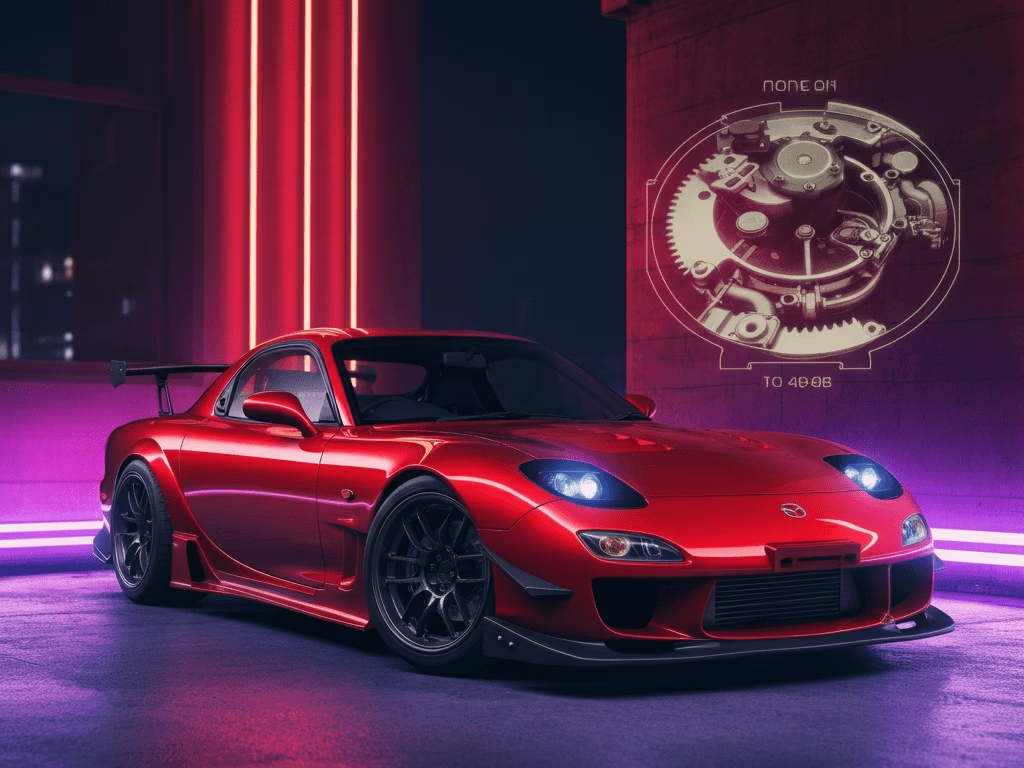
Instead of perfecting the piston engine like the rest of the world, Mazda took a totally different approach with the rotary engine.
The rotary engine uses a rotor, or two like the 13B, that spins inside a housing shaped like a sphere with a triangular shape instead of pistons that move up and down.
There are some astonishing benefits that come with this unusual JDM engine design:
- Fewer Moving Parts: Unlike a conventional four-cylinder piston engine, which has dozens of moving parts, such as piston rods, camshafts, valves, and springs, a twin-rotor engine consists of only three parts: two rotors and an eccentric shaft, allowing for smooth operation with minimal vibrations.
- Power-to-Size Ratio: The 1.3L 13B-REW engine from an FD Mazda RX-7, which produces 252 horsepower, is a prime example of a rotary engine, as each face of a rotor completes a cycle of combustion with every rotation of the eccentric shaft. The power a rotary engine produces is astonishing, considering the displacement.
- High-Revving: The unique, high-pitched rotary engine sounds that occur with revving, which are not limited by reciprocating mass, are a defining characteristic of the rotary engine. The 9000 revs per minute is heaven for any car lover.
The rotary engine presents several challenges, including apex seal wear and increased fuel and oil consumption however, it was revolutionary compared to the RX-7 and RX-8. The design is considered one of the most innovative in the JDM world.
Other Strengths in JDM Engines The Countries’ Engines that Don’t Get as Much Praise.
Japan has more underground power plants than the 2JZ, RB26, and VTEC. Apart from the engine types that get most of the glory, the rest get little attention.
These masterpieces remain underrated yet uniquely crafted engines with remarkable performance and tuning capabilities, offering more affordability than their popular counterparts.
Among the highly sought-after JDMs, the SR20DET stands out as exceptionally powerful within the drifting community.
It features a lightweight 2.0-liter turbocharged four-cylinder engine with an iron block. Comes with an SR20DET engine, similar to those found in the Silvia and 180SX, and is appreciated for its responsiveness and aftermarket support.
Proves to itself that JDM units can be powerful without six cylinders.
Touted as the centerpiece of the Lancer Evolution and more, the 4G63T is an iron-block beast of a 2.0 turbo.
Developed for over 20 years, Mitsubishi’s devotion towards this engine has considerably enhanced its value.
It is one of the most remarkable and dependable 4-cylinder engines due to its unmatched power and rough usage capability.
As with the rest, the EJ Series delivers power and an unmatched driving experience. Subaru’s EJ20 and EJ25 fill the gap in the line of turbo motors.
The famous Subaru rumble, powered by the boxer engine, is a hallmark of the WRX and STI. Known for its center of gravity.
Diving into the possibilities offered by these different mechanisms, including the forums on Grassroots Motorsports, will certainly open up whole new frontiers in the JDM tuning spectrum.
The JDM Engine Its Influence and How We intend to carry It forward.
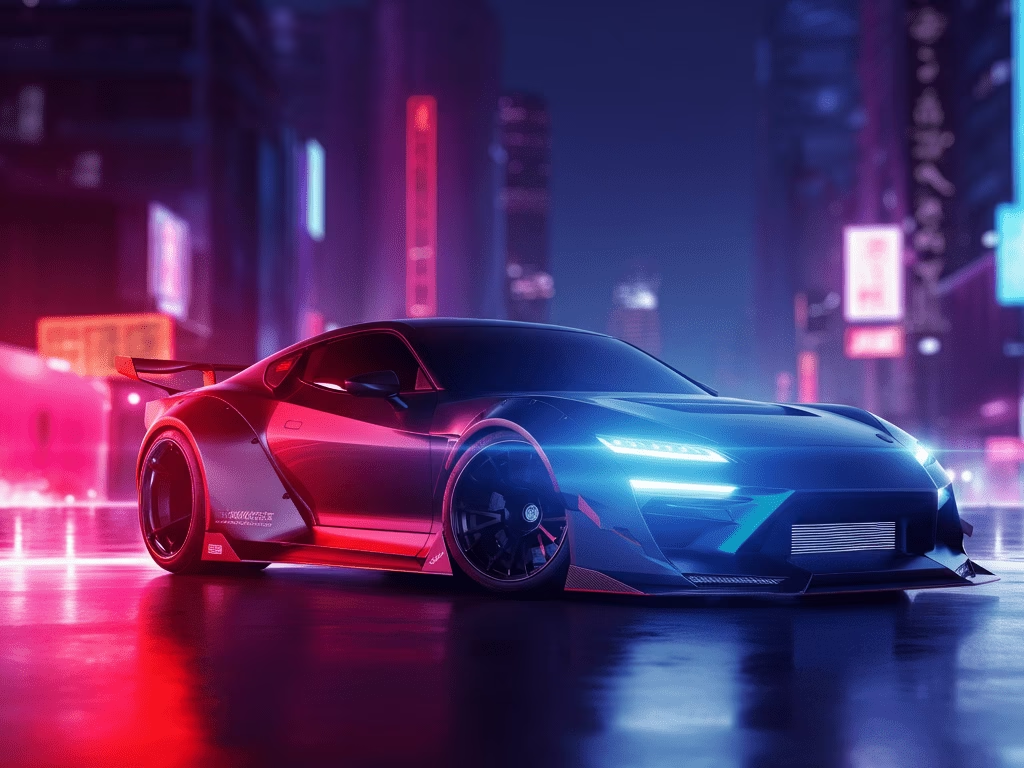
The legacy of the 1990s may seem distant, but the JDM engine remains alive and well. It was the first to demonstrate to the world that performance and reliability could come in the same package.
The first to demonstrate such exotic technologies, the world tuning really started to come from these machines, along with the rest of everything else.
The newly released Nissan Z and the GR Yaris embody the age-old philosophy of Japanese auto manufacturers, whose passion and devotion continue to yield new innovations: complex, electronically controlled engines that promise to excite and inspire their users.
More than mere technology, the JDM engine represents value, performance, and precision in its purest form.
FAQS Concerning JDM Engines
What sets apart a JDM engine from a normal engine?
A JDM engine is an engine crafted for the Japanese Domestic Market, usually has more powerful engine specs than the version that is exported. This could mean more powerful ECU tuning, more powerful internals, and a stronger compression ratio. These engines were made for and built in an industry reputed for power and industry durability exceeding the figures that are advertised and mired in “Gentlemen’s Agreement”.
Why are some JDM engines like the 2JZ-GTE so powerful?
Engines like the Toyota 2JZ-GTE are known for their power most engine from Japan during the economical boom, used durable materials and powerful structures making the engines to be over engineered for. These engine were known to have a closed deck iron block and forged steel crankshaft which alone showed a JDM engines ability to produced increased horsepower due to minimal modifications.
What is VTEC and Why is it so Famous?
VTEC is an abbreviation of Variable Valve Timing and Lift Electronic Control and is technology by Honda. It permits an engine to operate on 2 camshaft profiles. At low RPMs the engine uses a fuel economic profile, then shifts to a high performance profile at high RPMs, producing a sudden and exotic engine sound and surge of power. This is the epitome of practicality and power on demand.
Are Rotary Engines a Type of JDM Engine?
Yes. The rotary engine is a unique type of JDM engine and is the work of Mazda. Instead of a piston, it has a triangular rotor that spins within a housing. This has a phenomenal power to weight ratio, it runs smoothly and has the ability to rev high. The most well known is the 13B-REW found in a Mazda RX-7.
What is the best JDM engine for a project car?
The best JDM engine is subjective and will change depending on your objectives and your budget.
- To achieve massive power: The Toyota 2JZ-GTE and the Nissan RB26DETT are both legendary for their power.
- For a lightweight high revving engine: Honda K-series or B-series with VTEC are great options.
- For a great all-rounder: Nissan SR20DET and Mitsubishi 4G63T are equally powerful and reliable with decent aftermarket parts support, resulting in their popularity in drift and rally.
Are any JDM engines still produced?
Goes without saying, Japanese manufacturers still produce impressive engines. Though a lot of people glorify the ‘90s era, it certainly was still a time of great engines. Plus, new cars like the Toyota GR Yaris, Nissan Z and Honda Civic Type R also utilizes the new JDM engines, thus carrying the legacy of exciting and dependable performance.

